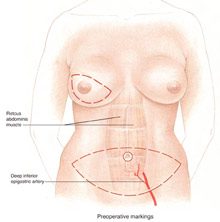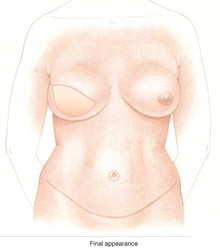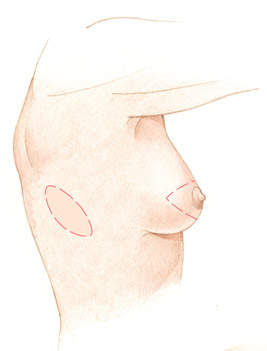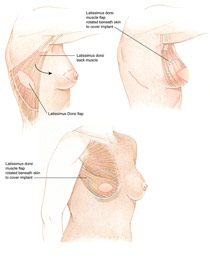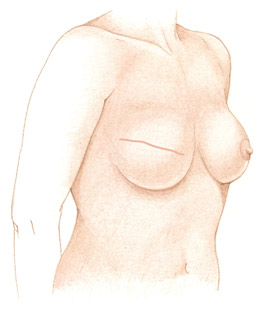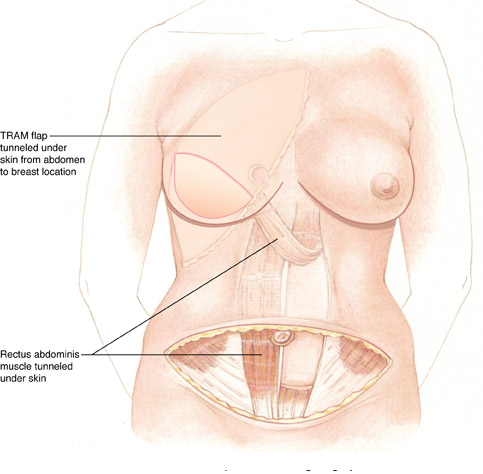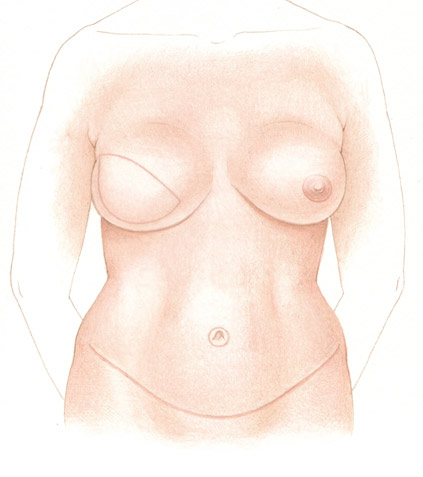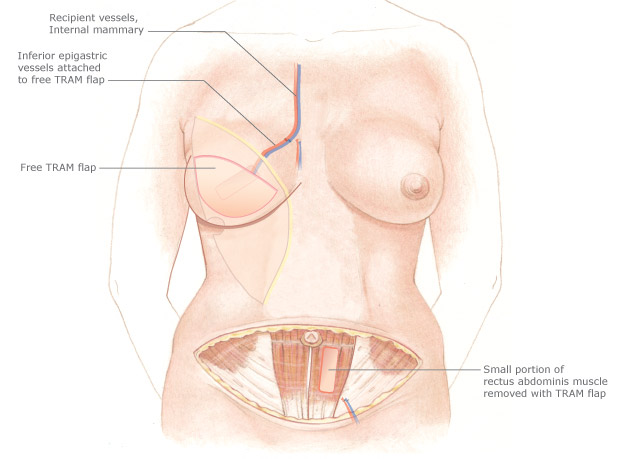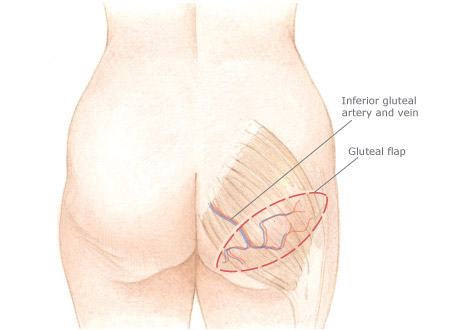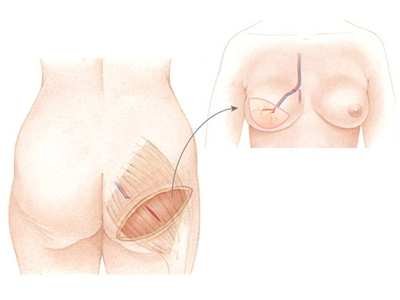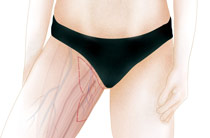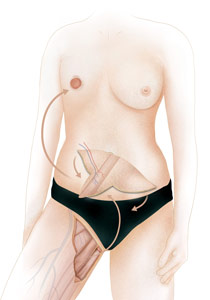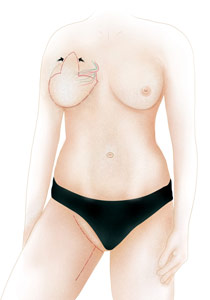With thanks to UK breast cancer support charity Breast Cancer Care for kind permission to use extracts from their patient information booklet Breast reconstruction.
Autologous Reconstruction
In autologous breast reconstruction, the breast is shaped using existing muscle, fat and skin (tissue) taken from other areas of the body.
There are five common areas of the body from which a breast flap can be formed for autologous reconstruction:
- DIEP (Deep Inferior Epigastric Artery Perforator) Flap uses tissue from the stomach area whilst preserving the abdominal muscle
- Latissimus Dorsi Flap uses tissue from the upper back and/or shoulder
- TRAM (Transverse Rectus Abdominis Muscle) Flap uses tissue from the stomach area
- SGAP (Superior Gluteal Artery Perforator) Flap uses tissue from the buttocks
- TMG/TUG (Transverse Myocutaneous Gracilis) Flap uses tissue from the inner thigh area
A DIEP (Deep Inferior Epigastric Artery Perforator) Flap uses tissue from the stomach area whilst preserving the abdominal muscle
The DIEP flap is one of the more commonly performed autologous procedures. This procedure uses a free flap of skin and fat, but no muscle, to form the new breast shape. The flap is taken from the lower abdomen along with the deep inferior epigastric artery and veins. It is then transferred to the chest and shaped into a breast while the artery and veins are connected to blood vessels in the armpit or chest wall using a specialised technique involving microvascular surgery (in a similar way to the free TRAM flap).
The advantage of this type of reconstruction is that no muscle has to be removed, so the strength of the abdomen is not affected. This means there is very little chance of developing a hernia and no mesh need be used. Like the pedicled and free TRAM flaps, the DIEP flap is a major procedure involving a long and complex operation, and the patient will need to be in good overall health to go through it. Recovery from this procedure will often be long.
A Latissimus Dorsi Flap uses tissue from the upper back and/or shoulder
This procedure uses the latissimus dorsi muscle-a large muscle that lies in the back just below the shoulder blade. The skin, fat and muscle are removed from the back but the blood vessels of the flap remain attached to the body at the end nearest the armpit (pedicled flap).
The flap is then turned and carefully threaded through a cut made below the armpit and is brought around to the front of the body to lie over the chest wall, forming the new breast (or part of the breast if being used in a breast-conserving operation). Some of the skin on the flap is used to form the new skin of the reconstructed breast, while the muscle and the fat are used to form the volume of the breast. It is usually necessary to use an implant under the flap after a mastectomy to help create a breast that is a similar size to the other one.
After fully recovering from an LD flap reconstruction, most women notice no significant weakness in the shoulder during everyday activities. Those who are very physically active, especially professional sportswomen, may notice some degree of weakness and/or stiffness, so consider this when deciding on the method of reconstruction best for your patient.
A TRAM (Transverse Rectus Abdominis Muscle) Flap uses tissue from the stomach area
There are two different types of TRAM flap operations:
In a pedicled flap, the rectus abdominis muscle, along with its overlying fat and skin and blood supply, is tunneled under the skin of the abdomen and chest and brought out over the area where the new breast is to be made. Usually there is enough fat in the flap to make the new breast the same size as the other one without the need for an implant.
In a free flap operation, the muscle, fat and skin are removed completely from the abdomen and the surgeon shapes a breast from this tissue. The blood vessels that supply the flap are re-connected to blood vessels in the region of the reconstructed breast, either under the armpit or behind the breastbone. Joining the vessels together is known as microvascular surgery.
The patient will need to be in good overall health to have either type of TRAM flap procedure. They will need to be non-smokers, have no existing scars on their abdomen (except perhaps a caesarean scar) and have enough fat in the lower abdominal area. If they are very overweight they may be advised to lose weight before being offered this type of operation.
A SGAP (Superior Gluteal Artery Perforator) Flap uses tissue from the buttocks
This procedure uses only fat and skin taken from the upper or lower buttock to create a new breast. Microvascular surgery is needed to join the blood vessels, and where tissue has been removed from the buttocks, there will be a scar and an indentation.
TMG/TUG (Transverse Myocutaneous Gracilis) Flap uses tissue from the inner thigh area
The tissue removed in this procedure is taken from the inner thigh and consists of skin, fat and a small strip of muscle. Microvascular surgery is needed to join the blood vessels, and the scar is placed in the fold of the groin and runs to the fold of the buttock area.
Artist's renderings| POTENTIAL ADVANTAGES | POTENTIAL DISADVANTAGES | ||||||||||||
|---|---|---|---|---|---|---|---|---|---|---|---|---|---|
|
|






